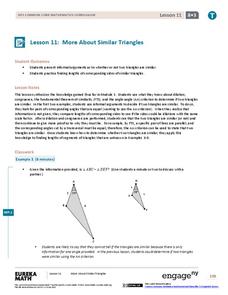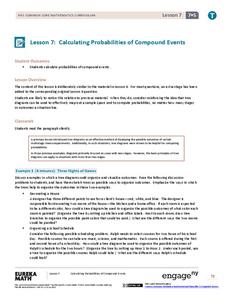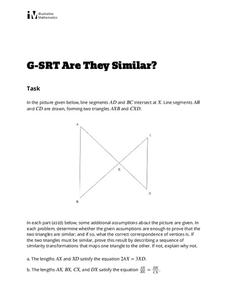EngageNY
More About Similar Triangles
Determine whether two triangles are similar. The lesson presents opportunities for pupils to find the criterion needed to show that two triangles are similar. Scholars use the definition of similarity to find any missing side...
EngageNY
Informal Proof of AA Criterion for Similarity
What does it take to show two triangles are similar? The 11th segment in a series of 16 introduces the AA Criterion for Similarity. A discussion provides an informal proof of the theorem. Exercises and problems require scholars to apply...
EngageNY
The Geometric Effect of Multiplying by a Reciprocal
Class members perform complex operations on a plane in the 17th segment in the 32-part series. Learners first verify that multiplication by the reciprocal does the same geometrically as it does algebraically. The class then circles back...
EngageNY
Calculating Probabilities of Compound Events
Use tree diagrams with multiple branches to calculate the probabilities of compound events. Pupils use tree diagrams to find the sample space for probability problems and use them to determine the probability of compound events in the...
EngageNY
The Structure of Ratio Tables—Additive and Multiplicative
Build tables by understanding their structure. Scholars take a closer look at the structure of ratio tables in the 10th segment in a 29-part series. Individuals realize that the tables can be built using an additive or multiplicative...
Teach Engineering
Exploring Energy: Kinetic and Potential
The potential of the energy in the class is moving. The third segment in a six-part unit on energy provides a deeper understanding of kinetic and potential energy. Learners understand the relationship between mass, speed, and energy and...
Curated OER
Corresponding Parts of Congruent Triangles
Students identify different parts of a triangle. In this geometry lesson, students differentiate between similar and congruent triangles. They use the navigator to crate a visual of the different parts of a triangle.
Curated OER
Rainbow Spelling: A Kinesthetic Approach to Encoding
Have your young learners interact with phonemes through this tactile plan! Each learner will have a colored mat where they connect different phonemes to create words. The best part is that they can self-correct easily as they spell!
Curated OER
Informative Essay Writing
High schoolers start by drawing Mr. Essay Man, who is supposed to illustrate the different parts of an essay. After discussing what each component should contain, writers start their essay, guided by the teacher and class discussion....
West Contra Costa Unified School District
Parallel Lines Cut by a Transversal
Parallel lines seem so right for each other. It's too bad they'll never, ever meet. Learners use tracing paper to discover relationships among angles formed by two parallel lines cut by a transversal. They apply this information to find...
Curated OER
Using the Sounds of Words Reading Task
Young readers demonstrate phonemic awareness in words and blends, and recognize 100 high-frequency words. Use a nursery rhyme to point out rhyming words, and change the words by putting a new letter at the beginning. Each learner will...
Pennsylvania Department of Education
What's My Sound?
Students follow a power point presentation to practice the sounds each letter of the alphabet make. In this 'what's my sound' lesson, students apply word recognition strategies and demonstrate listening and comprehension skills to build...
Curated OER
Optical Illusion
Students practice creating optical illusions as well as discerning how perception of information may change its characteristics. They distinguish between an equilateral triangle, endpoints, vertices's, and segments of triangles. The...
Biology Corner
Random Sampling
Simulate a random sampling of data by tearing 20 sheets of paper into slips and place a number on 10 and a letter on 10. They place the slips in two separate containers and randomly draw a number and a letter. They record their...
Curated OER
Calling on Congo
Students listen to an interview with a former news coorespondent in Congo. They discuss an article about the instability in the country following their elections. They research Congo's history along with its connection to the United...
Curated OER
Phoneme Recognition Games
Students explore language arts by completing an in-class phonics activity. In this word structure lesson, students utilize the Internet to identify the sounds that different letter combinations make. Students practice combining word...
Illustrative Mathematics
Are They Similar?
Learners separate things that just appear similar from those that are actually similar. A diagram of triangles is given, and then a variety of geometric characteristics changed and the similarity of the triangles analyzed. Because the...
EngageNY
Similarity and the Angle Bisector Theorem
Identifying and verifying reproducible patterns in mathematics is an essential skill. Mathematicians identify the relationship of sides when an angle is bisected in a triangle. Once the pupils determine the relationship, they prove it to...
EngageNY
Mid-Module Assessment Task - Geometry (Module 1)
How do you prepare class members for the analytical thinking they will need in the real world? An assessment requires the higher order thinking they need to be successful. The module focuses on the concept of rigid transformations...
Curated OER
Triangle Inequality Theorem
Students identify properties of triangles. In this geometry lesson, students create triangles using three different segments. They make conjectures and predictions.
Curated OER
Direction of River Flow
Students determine the direction the river flows. They use a US map with rivers listed, colored pencils and a compass or transparency with directions marked. Students use a color key to determine which direction the river is flowing...
Curated OER
Reflections
Fifth graders create a reflection of a poygon using a Mira. They discover that a line connecting a vertiex of a polygon and the corresponding vertex of its reflection is perpendicular to the line of reflection. Students create a glide...
Curated OER
Creating and Evaluating Ethnic Advertising
Learners examine the concept of ethnic advertising. In this African American history lesson plan, students watch segments of videos about the history of ethnic advertising. Learners respond to questions that correspond to each of the...
Curated OER
Match My Masterpiece
Fifth graders plot out points on grid paper which correspond with the ordered pairs they are given. If done correctly, the points form a word.

























